Alienware M11x R3: Portable Powerhouse
by Dustin Sklavos on July 22, 2011 1:15 AM EST4.4 Pounds of Gaming Performance
In all of our synthetic metrics, the Alienware M11x R3's updated processor and GPU helped it put in a strong showing against even full-voltage chips from the Arrandale generation. Sandy Bridge's aggressive Turbo Boost seems to be paying big dividends towards helping the line finally get out from under being heavily CPU-limited, so let's see how that pans out once we start using it for what it was intended for: gaming.
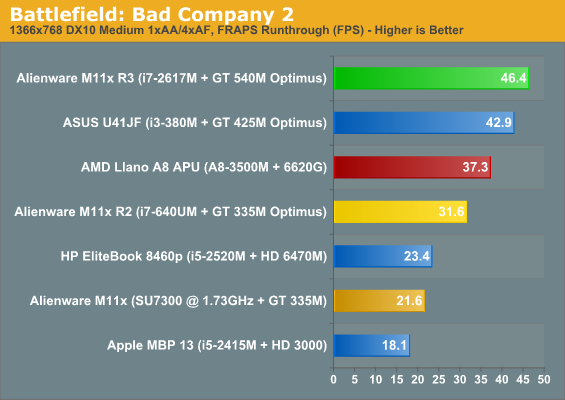
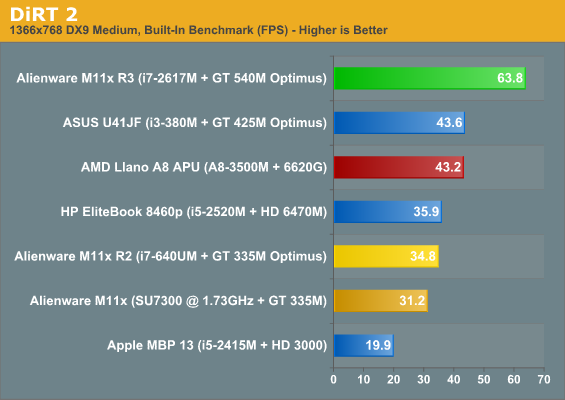
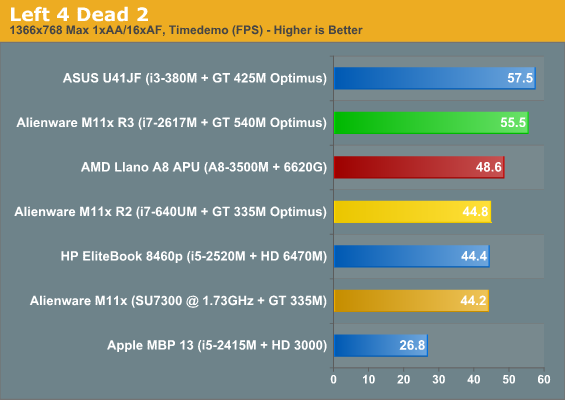
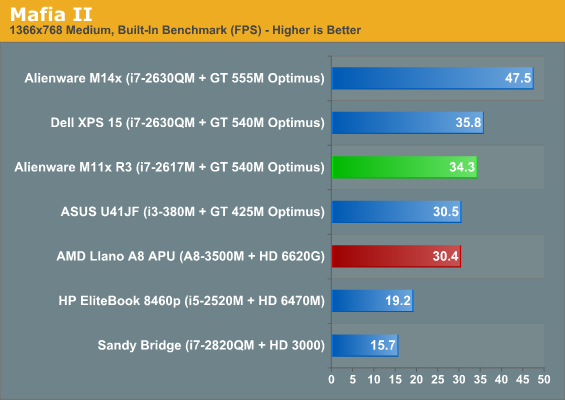
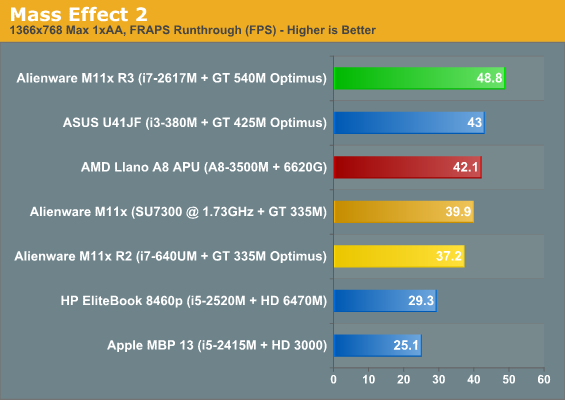
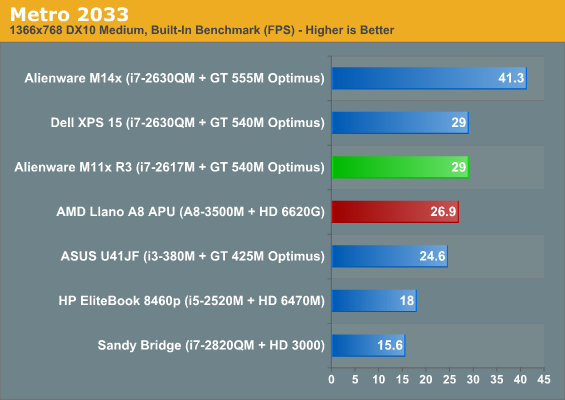
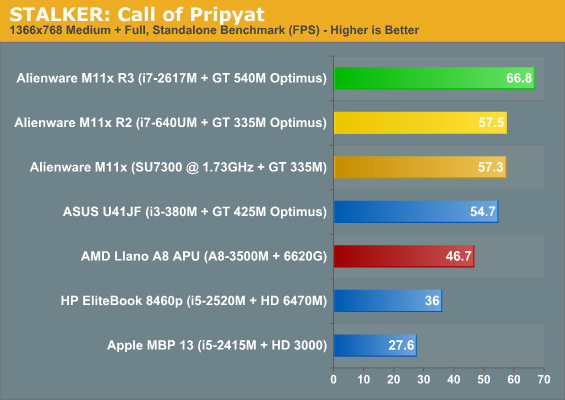
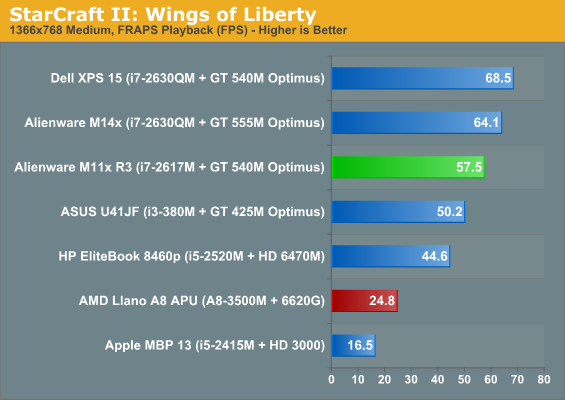
The combination of a faster processor and faster GPU seems to pay off handsomely for the M11x R3, but the big news is definitely that the CPU limitations that tended to plague performance on the last two generations are mostly ameliorated by the i7-2617M. It's difficult to gauge how deleterious an effect downgrading to the i5-2537M would have on the M11x R3's gaming performance, but at these settings we appear to be largely GPU-limited. Pay special attention to those Mafia II results: Mafia II has a tendency to stress every part of a system in a way few games do these days, and for that reason I actually use it to max out power consumption when I do desktop testing. Nothing else really comes close.
We have added a few titles since the M11x R2 review, specifically Mafia II, Metro 2033, and StarCraft II. That means we don't have the same set of laptops in those charts, so we added a couple other laptops to flesh things out. You can get a full comparison of how the smaller M11x R3 stacks up against the Dell XPS 15 in Mobile Bench, or you can compare the M11x R3 with it's big brother, the M14x we reviewed earlier this week. Considering the difference in chassis size and CPU performance, it's pretty clear that the i7-2617M isn't holding the GT 540M back much; the M14x on the other hand still gets a healthy boost from the GT 555M. Moving to our High settings will obviously stress the hardware more, but we've included the native 768p results for the M11x as well.
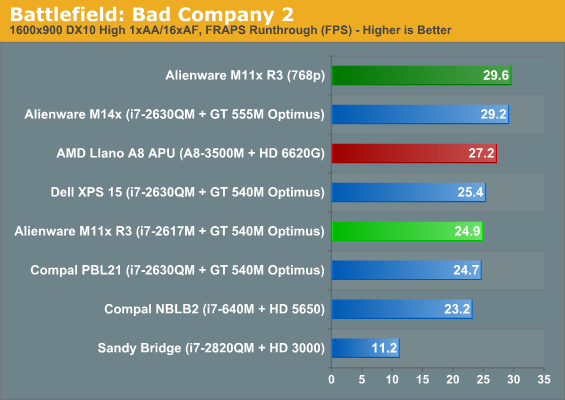
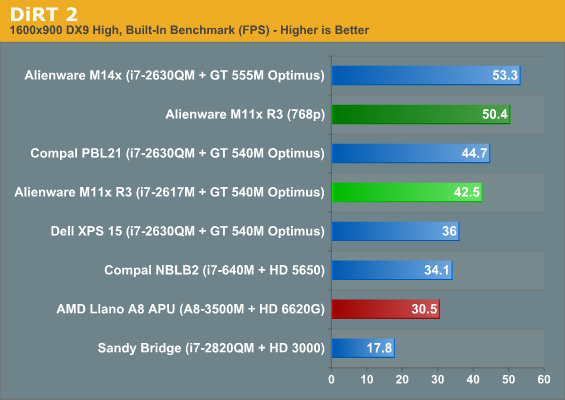
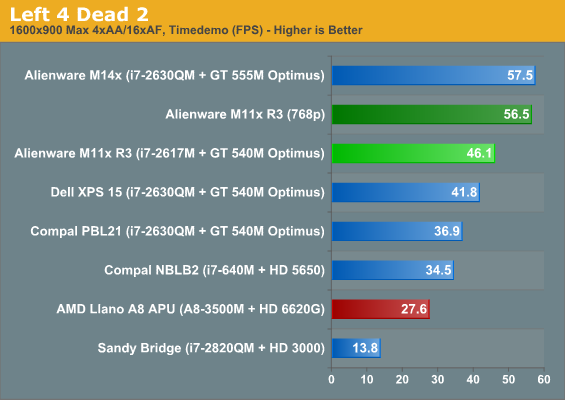
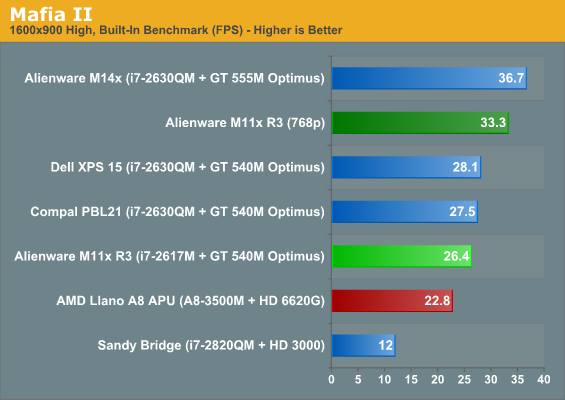
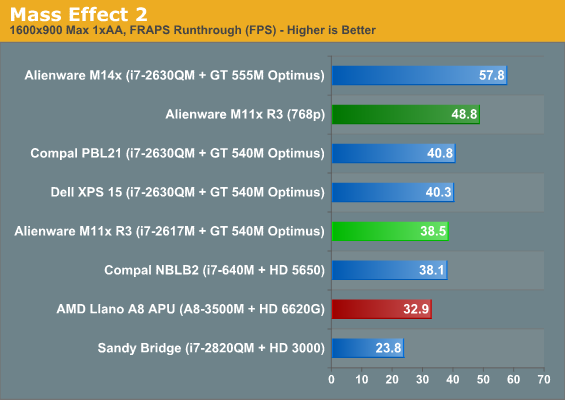
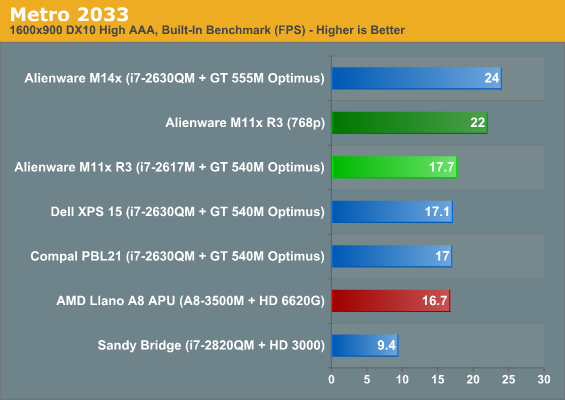

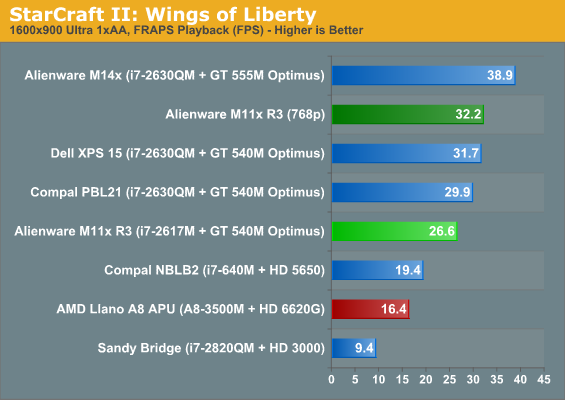
At our "High" preset the M11x R3 continues to put in a strong showing, and most of these games are actually quite playable at the notebook's native 1366x768 resolution. It appears that we're again heavily GPU-limited here, which is fantastic given the low voltage processor. The 17W TDP of the i7-2617M (and the i5-2537M) is as low as Sandy Bridge goes, one watt lower than the previous generation's i7-640UM.










55 Comments
View All Comments
DanNeely - Saturday, July 23, 2011 - link
60hz is 17ms per frame; once response times dropped below that level they ceased to be anything except bogostats used by marketing people.GraveUypo - Wednesday, August 17, 2011 - link
are you serious? really? god. this is even worse than the "humans can't tell apart more than 30fps so there's no point to it" argument. i had to register just to reply to this.if you have a "17ms" monitor, by the time the screen is fully set on a frame, it already has to transition into the next, so it'll be showing blends of two neighbouring frames ALL THE TIME. you'll NEVER get a crisp picture on ANY moving/changing picture.
and yes, responses are still very much relevant. try reading movie credits on a LCD panel then on a plasma panel (or even play games on them) and you'll see how obvious the frame lag is on LCDs.
heck, i always thought gears of war 2 had heavy motion blur on it until i played it on my plasma tv. picture was so clear on moving scenes i thought the game was missing some shaders.
anyways, response times will be irrelevant when those transitions are all under 0,5ms. with 5ms it just hit the spot where it's usable (yes, 2ms is a lot better but still not quite there yet).
Snotling - Friday, July 22, 2011 - link
Whatever the manufacturer, finding a laptop with a good display is a challenge... basically there isn't much incentive for them to try any harder much the opposite:people buy the display by the inch, not by the pixel count. (sometimes the pixel count is not even easily available in the product description)
Contrast and color information is basic at best in any spec sheet.
People don't care because they don't realize that even word processors and spreadsheets need visible LINES of display space to be useful (stupid 16:9 ratio doesn't help... more inches, less workspace)
We're losing the battle
Madcatatlas - Friday, July 22, 2011 - link
Where did the bigger Alienware and Clevo laptop reviews go? the ones sporting 6970ms and 6990m?These small laptops are no good for even light gaming. Gives a man a headache.
ph0masta - Friday, July 22, 2011 - link
Good machine for the size, but you can still buy a faster notebook with full 1080p screen at 15-17" from Digital Storm, for around the same price.CZroe - Friday, July 22, 2011 - link
I've owned an M11x r1 for over a year and now own an r3. I wanted to point out that the indicator strip has changed (was almost impossible to see Caos or WiFi status LEDs before), though that likely happened during the r2's life, and the rubberized texture is new to the r3. The WiFi toggle doesn't actually toggle anything anymore, it just launches a software dialog with check boxes for WiFi, Blueooth, and Mobile Broadband.It takes a Dell Wireless 375 Bluetooth 3.0 adapter, which can be added by the user if the cable is present internally (mine was). The r1 and r2 used a DW365 BT 2.1 adapter that conneted directly (no cable needed).
The left USB port remained powered when the r1 was off or asleep as long as the battery had over 10% charge. I used this feature all the time to charge othe devices without running my notebook dead nearly as fast as if I booted, so I was disappointed to find that it usually doesn't work on the r3 (different between asleep and off). Oh well. Reviewers often misinterpreted it and reported that the notebook only had one "powered" USB port, which was untrue, so maybe they got rid of the feature and I'm only able to charge when it's not fully asleep or something.
The article seems to be saying that it would take a 12.1" panel size bump to consider a good IPS panel but the 11.6" MacBook Air has obviously sourced one. Also, the MBA has an unexpectedly large bezel, just like the M11x. Now that they got rid of the discrete GPU in the refresh with a backlit keyboard, it's even less comparable and I'd no longer consider it in comparison to the M11x.
I was able to compare the r1 and r3's audio side-by-side and the new "Klipsch" speakers sound very different. I'm somewhat hard-of-hearing, so I'll just assume that the quality was better, but the volume was notably lower. It was already frustratingly low for me the first time. Looking inside, they look identical. One of the two is still placed almost in the center, but I don't expect much stereo separation in such a small chassis anyway. I am disappointed that this article didn't touch on the strange Sound Blaster software configuration option. Most people would love an explanation of that! They ask $20 to add what, exactly, to the integrated sound? Is it just a software EAX wrapper? Has Creative joined those they can't beat?
I didn't see any mention of the dual microphones in the display. They should help with noise canceling in a crounded room. They are both farther away from the webcam than the single mic on the r1/r2, but the dimensions are otherwise identical. The webcam/mic cut in the official Green Onion Supply AG2 anti-glare filter/screen protector no longer suffices, so I had to use a hole punch to make two holes. I also spoke with the creators of Invisible Defenders and they supposedly updated their templates, but I don't see the change on their site.
I can suggest a couple more changes for the future than the article suggests. Make the touch pad as large as will fit, like Apple does, and stop truncating keys like the shift key just to keep from shifting the arrow keys down. There is no reason for the keyboard to be perfectly rectangular. The M14x has them shifted down and there is obviously plenty of open space in the palm-rest area. The tiny rear rubber feet always come off eventually and they have remained unchanged. I had problems with the palmrest rubber bumpers as well (holds the screen above the keys when closed). The keyboard backlighting us not needed when the display is closed, so they should be hard-wired to turn off and save batter when closed, the same as the backlight. Of course, this is when you set the lid sensor to "do nothing." At least it doesn't interrupt a manual sleep and hard-lock it like the M11x r1 did if you closed it before it finished entering sleep (obviously, it was doing SOMETHING).
I also want to mention that the DW375 BT module doesn't seem to have improved range at all. I still sometimes find that I am operating my BT Razer Orochi mouse too far away on the same lapboard as the notebook, which is annoying (mouse pointer stutters and lags until you get closer). Gaming on battery power with "balanced" settings isn't always great. For instance, the initial GlaDOS encounter in Portal 2 gets really choppy unless you are plugged in and set to high performance, but the rest of that particular game seems fine so you may find yourself doing it anyway.
That's it for now. I still love the notebook and will put it to good use.
Guspaz - Friday, July 22, 2011 - link
Dell has been shilling the software SoundBlaster stuff for years; I had the same option on my Inspiron 9400 (e1705 in the US) when I bought it four or five years ago. It's just as you say: all it really does of worth is emulate EAX in software, as well as providing a DirectSound3D to OpenAL wrapper, which lets older games use surround audio (and EAX) on Vista or 7.This is of limited use, since modern games tend not to use EAX (environmental audio is normally handled by the game's sound engine itself), and support Vista/7's native 3D audio API.
EAX stopped being relevant when Half-Life 2 and Doom 3 came out seven years ago, and both did all their audio processing internally.
CZroe - Friday, July 22, 2011 - link
Thanks. I know is that it wasn't available for the M11x back when I bought my r1 but is is available for the r3.seapeople - Saturday, July 23, 2011 - link
Macbook's (including the Air) use TN panels.The issue here is that there are good TN panels, mediocre TN panels, and BAAAAAAAAAAD TN panels. My experience suggests the following:
Good TN panels generally go on stand alone monitors (which are in turn considered poor compared to much more expensive IPS panels).
Mediocre TN panels are usually the best we get on laptops (i.e., anything apple, or some of the higher resolution upgrade options on Dell, etc).
BAAAAAAAAAAD TN panels are what we get standard on pretty much every laptop made today, usually at 1366x768. Actually, if your panel is 1366x768, there's probably a 99% chance it's a bad one, because most of the better quality TN panels are also higher resolution. In fact, it may have been literally impossible for Alienware to source a better quality TN panel at the 1366x768 resolution, without working out some exorbitantly expensive deal. Since they probably did not want to increase the resolution since this is a gaming laptop, I bet this is why we are stuck with a horrible panel.
Beenthere - Friday, July 22, 2011 - link
I was considering the M11x but it's too ugly and only available with an InHell CPU. If it was better looking and available with an AMD A8-3530mx I'd be seriously interested.